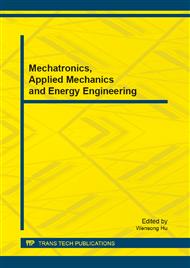[1]
F.R. Wang, Z.X. Li. Microscale Thermal Science and its Applications in MEMS. Instrument Technique and Senser, 2002, 7: 1-4.
Google Scholar
[2]
C. Harper. Electronic Packaging and Interconnection Handbook (4th edition). New York: McGraw-Hill Professional, (2004).
Google Scholar
[3]
R. Ulrich, W. Brown. Advanced Electronic Packaging (2nd edition) . New York: Wiley, (2006).
Google Scholar
[4]
H.Y. Wu, P. Cheng. An experimental study of corrvective heat transfer in silicon micro channels with different surface conditions. Int. J. Heat Mass. Transfer 2003, 46: 2547-2556.
DOI: 10.1016/s0017-9310(03)00035-8
Google Scholar
[5]
T. Y. Lin, G. S. Kandlikar. A Theoretical Model for Axial Heat Conduction Effects During Single-Phase Flow in Microchannels. Journal of Heat Transfer. 2012, 134: 1-6.
DOI: 10.1115/1.4004936
Google Scholar
[6]
K. Aziz, J. Rahim. Heat transfer and pressure drop experiments on CMOS compatible microchannel heat sinks for monolithic chip cooling applications. International Journal of Thermal Sciences, 2012, 56: 77-85.
DOI: 10.1016/j.ijthermalsci.2012.01.006
Google Scholar
[7]
G. Hetsroni, A. Mosyak, E. Pogrebnyak, et al. Heat transfer in micro-channels: comparison of experiments with theory and Numerical results. International Journal of Heat and Mass Transfer, 2005, 48: 5580–5601.
DOI: 10.1016/j.ijheatmasstransfer.2005.05.041
Google Scholar
[8]
M.R. Salimpour, M. Sharifhasan Constructal, E. Shirani. Optimization of the geometry of an array of micro-channels. International Communications in Heat and Mass Transfer, 2011, 38: 93–99.
DOI: 10.1016/j.icheatmasstransfer.2010.10.008
Google Scholar
[9]
Y. L. Liu, X. B. Luo. Experimental research on a honeycomb microchannel cooling system. IEEE Components, Packaging And Manufacturing Technology, 2011, 1(9): 1378-1386.
DOI: 10.1109/tcpmt.2011.2162331
Google Scholar
[10]
G. B. Zhou, S. C. Yao. Effect of surface roughness on laminar liquid flow in micro-channels. Applied Thermal Engineering, 2011, 31: 228-234.
DOI: 10.1016/j.applthermaleng.2010.09.002
Google Scholar
[11]
C. Jundika, P.K. Agus, S.M.S. Arun. Numerical investigation of laminar heat transfer performance of various coolingchannel designs. Applied Thermal Engineering. 2011, 31: 1293-1304.
DOI: 10.1016/j.applthermaleng.2010.12.036
Google Scholar
[12]
L. Gong, K. Kota, W.Q. Tao, Y. Joshi. Thermal Performance of Flow and Heat Transfer in Wavy Channels. ASME Journal of Heat Transfer, 2011, 133(5), 051702(1-10).
DOI: 10.1115/1.4003284
Google Scholar


